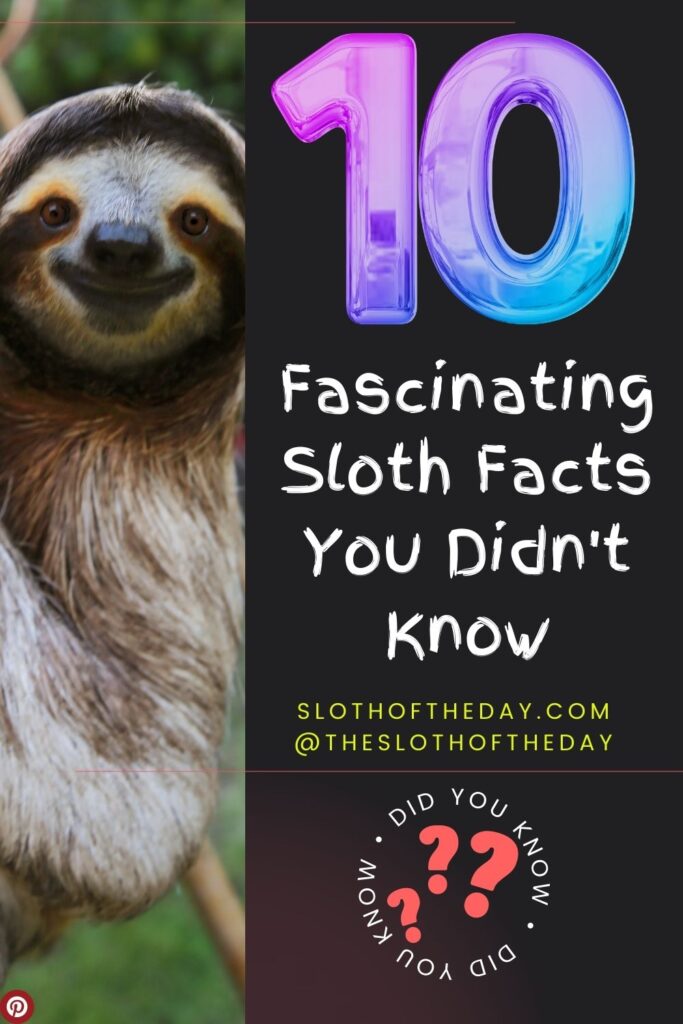Table of Contents
Fascinating Sloth Facts You Didn’t Know. Here we bring you 10 fascinating sloth facts that you may not be aware of. Which one did you know?
In this blog post, we explore 10 fascinating sloth facts that will surely leave you amazed. From their slow-paced lifestyle to their unique adaptations, sloths are undeniably intriguing creatures.
10 Fascinating Sloth Facts You Didn’t Know
Follow Us On YoutubeWe Will Be Covering Some Fascinating Sloth Facts in This Post
- Why Are Sloths So Fascinating?
- Fact 1: Sloths are the world’s slowest mammals
- Fact 2: Sloths live upside-down
- Fact 3: Sloths have a low metabolic rate
- Fact 4: Sloths have algae growing on their fur
- Fact 5: Sloths only defecate once a week
- Fact 6: Sloths are excellent swimmers
- Fact 7: Sloths have a unique digestive system
- Fact 8: Sloths have long, sharp claws
- Fact 9: Sloths have a complex social structure
- Fact 10: Sloths face threats to their survival
Learn how sloths thrive in their natural habitat, their astonishing climbing abilities, and their unusual digestive system. Discover their surprising sleeping patterns and why they love to hang upside down.
Delve into their fascinating camouflage techniques and understand why algae grow on their fur. Get ready to be captivated by the mysterious world of sloths as we uncover intriguing facts you never knew about these adorable and incredible animals.
Why Are Sloths So Fascinating?

What are sloths? Sloths are slow-moving mammals that inhabit the rainforests of Central and South America. They belong to the family Bradypodidae and are known for their unique lifestyle and adaptations.
Why are they fascinating? Well, sloths have a myriad of intriguing traits and behaviors that set them apart from other animals, making them a subject of fascination for researchers and animal lovers alike.
Fact 1: Sloths Are The World’s Slowest Mammals

Sloths have lengthy limbs and curved claws that allow them to cling to tree branches; this is one of their physical adaptations that allows them to move so slowly.
This slow mobility can be ascribed to their low muscle mass as well as their nutrition, which is poor in energy and consists of leaves and buds for the most part.
Comparison of sloth speed to that of other animals: Although sloths may appear to move at a glacial pace, this is actually the result of their peculiar way of existence rather than any inherent physical limits.
In point of fact, when it comes to the management of energy, sloths are the most resourceful animals that can be found everywhere in the animal kingdom.
Fact 2: Sloths live upside-down
Why do they hang upside down? Sloths have evolved to spend the majority of their lives hanging upside down from tree branches. This behavior provides them with several advantages, including camouflage, safety from predators, and easier access to their primary food source, leaves.
Unique anatomical features supporting upside-down life: Sloths have specialized adaptations that enable them to hang upside down for extended periods without experiencing any discomfort or strain. These include specially designed tendons and muscles that keep them securely attached to branches.
Fact 3: Sloths have a low metabolic rate
 Consequences of a slow metabolism: Due to their slow-paced lifestyle, sloths have a remarkably low metabolic rate.
Consequences of a slow metabolism: Due to their slow-paced lifestyle, sloths have a remarkably low metabolic rate.
This means that their bodies operate at a much slower pace compared to other mammals.
As a result, they have a lower body temperature and slower heart rate. How do they survive with such low energy consumption?
Sloths have adapted to their low-energy diet by conserving energy through their slow movement and by having a reduced need for frequent eating.
Their digestive system is also specialized to extract maximum nutrients from their fibrous plant-based diet.
Fact 4: Sloths have algae growing on their fur
Symbiotic relationship with algae: Sloths’ fur is often covered in algae, which gives them a greenish appearance. While this may seem like a disadvantage, it actually benefits sloths by providing them with additional camouflage in their forest environment.
The algae also benefit from the sloths’ fur, as it provides them with a stable and nutrient-rich environment to grow. Benefits and challenges of having algae-covered fur: The algae-covered fur helps sloths blend into their surroundings, making them less visible to predators.
However, it also adds weight to their fur, making it more challenging for them to move quickly.
Fact 5: Sloths only defecate once a week
 The explanation for infrequent bathroom visits: Sloths have an incredibly slow digestive system, which means that it takes a long time for food to pass through their bodies.
The explanation for infrequent bathroom visits: Sloths have an incredibly slow digestive system, which means that it takes a long time for food to pass through their bodies.
As a direct consequence of this, they only have to use the restroom once a week. What kind of trash management do they practice?
After waiting for what seems like an eternity, a sloth will finally feel the need to defecate.
At this point, it will leave the safety of the trees and carefully choose a location on the ground.
It is believed that these activities help fertilize the forest floor and provide essential nutrients for plants.
Fact 6: Sloths are excellent swimmers
Surprising swimming abilities despite slow movement on land: Despite their sluggish nature on land, sloths are surprisingly adept swimmers.
They use their long arms to paddle through the water and can hold their breath for up to 40 minutes. Adaptations for swimming: Sloths’ long limbs and webbed hands and feet allow them to move efficiently through the water.
Swimming also helps them navigate between trees and different parts of their forest habitat.
Fact 7: Sloths have a unique digestive system
 Sloths have a highly specialized diet that consists primarily of leaves, and this diet fulfills all of their nutritional requirements.
Sloths have a highly specialized diet that consists primarily of leaves, and this diet fulfills all of their nutritional requirements.
These leaves are difficult to digest and offer very little in the way of nutritional benefit.
Sloths have a longer digestive tract than other mammals, which helps them break down their food and extract as many nutrients as they can from it. This helps them make up for their slow metabolism.
What makes their digestive system unique in comparison to that of other mammals: Sloths, in contrast to most other animals, have a complex stomach with many chambers that are home to specific bacteria.
These bacteria assist in breaking down the stiff cellulose that is present in leaves, which makes it simpler for sloths to access the nutrients they need.
Fact 8: Sloths have long, sharp claws
Role of claws in their survival: Sloths possess long, sharp claws that are well-suited for their arboreal lifestyle.
These claws allow them to grip tree branches securely and navigate their environment with ease. Do sloths use their claws for defense? While sloths’ long claws may seem intimidating, they primarily serve as a tool for survival rather than defense.
Sloths rely on their camouflage and slow movement to avoid predators, and their claws help them maintain a strong grip on their tree branches.
Fact 9: Sloths have a complex social structure
 The reclusive character of sloths, in addition to the occasional interactions with others that they do have. Sloths are creatures that, for the most part, choose to remain alone themselves, but on occasion, they will interact with other sloths or other species.
The reclusive character of sloths, in addition to the occasional interactions with others that they do have. Sloths are creatures that, for the most part, choose to remain alone themselves, but on occasion, they will interact with other sloths or other species.
This is especially true during the mating season when males are actively hunting for females in order to mate with them.
During this time, the males are more aggressive than usual in their search. Connections that exist between parents and their offspring: It is common knowledge that female sloths are excellent mothers due to their capacity to nurture and guard their young over a protracted period of time. This ability allows them to raise their young successfully.
The young sloths are known as “slothlets,” and they stay with their mothers for as long as a year after they are born.
The infant sloths are referred to as “slothlets,” and they remain with their moms for up to a year.
Fact 10: Sloths face threats to their survival
Habitat destruction and fragmentation: Sloths are increasingly threatened by habitat loss due to deforestation and urbanization. As their natural habitats are destroyed or fragmented, sloths face difficulties finding sufficient food and suitable living conditions.
Predators and human impacts: Sloths also face predation from animals such as jaguars, harpy eagles, and snakes. Additionally, they are sometimes victims of human activities, including poaching and the illegal pet trade. Conservation efforts are crucial in protecting and preserving these unique creatures.
We have 4 articles that cover the threats that Sloths face in their survival. The short of it all is that Habitat Loss is the main cause that may drive them to extinction.
Men themselves it is their best and worst enemy at the same time. You can read more about this topic by following the links.
- Sloth Habitat Loss Could Cause Sloth Extinction
- What are The Dangers of Sloth Habitat Loss?
- What are The Causes of Sloth Habitat Loss?
- Can You Help Prevent Sloth Habitat Loss
Other Posts You Might Like
[featured_image_pro id=’5′]- Fun Facts About Sloths 10 Interesting Facts Video
- Sloth Facts for Kids 101 Classroom Video Course
- Amazing Facts About Sloths Video (10)
- Odd Sloth Facts Educational Sloth Video
Fascinating Sloth Facts

As a sloth lover, I could talk about all these fascinating sloth facts all day. But also as a sloth, I was gonna procrastinate today… but I never got around to it 🙂
We started Sloth of The Day many years ago to talk about Sloths. Along the way, we started the Youtube Channel, Facebook Page, and Instagram as well again to talk about sloths.
Along the way, we have learned a lot and have met some cool fellow sloth lovers. Hope you have enjoyed this Fascinating Sloth Facts Post. Please let us know in the comments.
We love making sloth gear here at Sloth of The Day. You can see some of the sloth books we have made @ Leo Garcia Books.
THANK YOU FOR VISITING SLOTH OF THE DAY

We are always seeking sloth images, sloth stories, and sloth videos to share with our readers. We have more sloth content for you to enjoy. You can find more Sloth Articles, Sloth Videos, and gear from our Sloth Store.
If you have any of the above available please send them our way. We would be happy to share them.
Find us on the Web: Facebook – Youtube – Instagram
If you have any questions, please contact us or check out our About Us page.
If you happen to enjoy our 10 Fascinating Sloth Facts You Did Not Know post please let us know in the comments below
We hope you have a great Sloth Day. Sloth On!
How Did We Do?
| Thanks for stopping by! Did the article make your day brighter or clearer? Tell us how we did in the comments below! | |
| Support This Page | Store - Books - T-shirts - Amazon - Buy Us a Coffee |
|---|---|
| Follow Us | Facebook - Instagram - Youtube |
| Contact | Contact Us - About Us |
| Sharing is Caring | If you have enjoyed this article please take a moment to SHARE it. Thank you very much. |


















